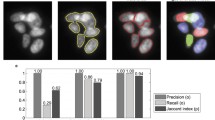Abstract
We describe a new technique to automatically segment and track the cell images of a breast cancer cell line in order to study cell migration and metastasis. Within each image observable cell characteristics vary widely, ranging from very bright completely bounded cells to barely visible cells with little to no apparent boundaries. A set of different segmentation algorithms are used in series to segment each cell type. Cell segmentation and cell tracking are done simultaneously, and no user selected parameters are needed. A new method for background subtraction is described and a new method of selective dilation is used to segment the barely visible cells. We show results for initial cell growth.
This contribution of NIST, an agency of the U.S. government, is not subject to copyright.
Access this chapter
Tax calculation will be finalised at checkout
Purchases are for personal use only
Preview
Unable to display preview. Download preview PDF.
Similar content being viewed by others
References
Chaffer, C.L., Weinberg, R.A.: A perspective on cancer cell metastasis. Science 331, 1559–1564 (2011)
Miller, F.R., Santner, S.J., Tait, L., Dawson, P.J.: MCF10DCIS.com xenograft model of human comedo ductal carcinoma in situ. J. Natl. Cancer. Inst. 92, 1185–1186 (2000)
Simon, I., Pound, C.R., Parin, A.W., Clemnes, J.Q., Christens-Barry, W.A.: Automated Image Analysis System for Detecting Boundaries of Live Prostate Cancer Cells. Cytometry 31, 287–294 (1998)
Tscherepanow, M., Zollner, F., Hillebrand, M., Kummert, F.: Automatic Segmentation of Unstained Living Cells in Bright-Field Microscope Images. In: Perner, P., Salvetti, O. (eds.) MDA 2008. LNCS (LNAI), vol. 5108, pp. 158–172. Springer, Heidelberg (2008)
Zhang, K., Xiong, H., Yang, L., Zhou, X.: A Novel Coarse-to-Fine Adaptaton segmentation Approach for Cellular Image Analysis. In: Cham, T.-J., Cai, J., Dorai, C., Rajan, D., Chua, T.-S., Chia, L.-T. (eds.) MMM 2007. LNCS, vol. 4351, pp. 322–331. Springer, Heidelberg (2006)
Zanella, C., Campana, M., Rizzi, B., Melani, C., Sanguinetti, G., Bourgine, P., Mikula, K., Peyrieras, N., Sarit, A.: Cells Segmentation from 3-D Confocal Images of early Zebrafish Embryogeneis. IEEE Transactions on Image Processing (September 2009)
Wang, M., Zhou, X., Li, F., Huckins, J., King, R.W.: Novel cell segmentation and online SVM for cell cycle phase identification in automated microscopy. Bioinformatics 24(1), 94–101 (2007)
Palaniappan, K., Ersoy, I., Nath, S.: Moving object segmentation using the flux tensor for biological video microscopy. In: Ip, H.H.-S., Au, O.C., Leung, H., Sun, M.-T., Ma, W.-Y., Hu, S.-M. (eds.) PCM 2007. LNCS, vol. 4810, pp. 483–493. Springer, Heidelberg (2007)
Stuelten, C.H., Busch, J.I., Tang, B., et al.: Transient tumor-fibroblast interactions increase tumor cell malignancy by a TGF-Beta mediated mechanism in a mouse xenograft model of breast cancer. PLoS One 5, e9832 (2010)
Tang, B., Vu, M., Booker, T., et al.: TGF-beta switches from tumor suppressor to prometastatic factor in a model of breast cancer progression. J. Clin. Invest. 112, 1116–1124 (2003)
Friedman, N., Russell, S.: Image segmentaton in video sequences: a probabilistic approach. In: Proceedings 13th Conference Uncertainty Artificial Intelligence (1997)
Kachouie, N.N., Fieguth, P., Ramunas, J., Jervis, E.: A Statistical Thresholding Method for Cell Tracking. In: IEEE International Symposium on Signal Processing and Information Technology (2006)
Author information
Authors and Affiliations
Editor information
Editors and Affiliations
Rights and permissions
Copyright information
© 2011 Springer-Verlag Berlin Heidelberg
About this paper
Cite this paper
Peskin, A.P., Hoeppner, D.J., Stuelten, C.H. (2011). Segmentation and Cell Tracking of Breast Cancer Cells. In: Bebis, G., et al. Advances in Visual Computing. ISVC 2011. Lecture Notes in Computer Science, vol 6938. Springer, Berlin, Heidelberg. https://doi.org/10.1007/978-3-642-24028-7_35
Download citation
DOI: https://doi.org/10.1007/978-3-642-24028-7_35
Publisher Name: Springer, Berlin, Heidelberg
Print ISBN: 978-3-642-24027-0
Online ISBN: 978-3-642-24028-7
eBook Packages: Computer ScienceComputer Science (R0)




